The HTC 10 Review
by Joshua Ho on September 19, 2016 8:00 AM ESTBattery Life
Battery life is still one of the most important aspects of any mobile device, and as a result our testing of a mobile device needs to properly emphasize this aspect. As a result, it’s important that every device is tested in the same manner to avoid bias in one way or another. In order to achieve this, all devices have all possible background services disabled, as well as sync and automatic app updates. In order to try and make an even comparison we also set the display to 200 nits brightness on a 100% average picture level display, also known as a blank white screen. However, one area that we aren’t necessarily able to control for 100% of the time is ambient temperature, device orientation, or material contact. While tests that don’t reach TDP limits won’t see any effects, TDP-limited tests will see a delta here, but it’s hard to estimate just how much of an impact exists here. While we might be able to do some power characterization, in most cases review units are not allowed to be torn down and with a general decrease in the number of devices with removable batteries power characterization has to be done through the fuel gauge which is often unreliable. With the HTC 10, this fuel gauge is only updated every minute so there’s realistically no way to actually test power outside of full rundown tests.

In our first test we can see that the Galaxy S7 is actually slightly down on power efficiency relative to the HTC 10. I went back and ran the HTC 10 on our basically display-bound battery life test and the Galaxy S7 gets around 12.34 hours while the HTC 10 gets 11.63 hours. That’s about a 5-6% delta which is almost entirely down to display efficiency, so I suspect that the difference here is actually due to optimizations in DVFS and other optimizations that would probably fall under the “PowerBiotics” branding that HTC seems to be using here.
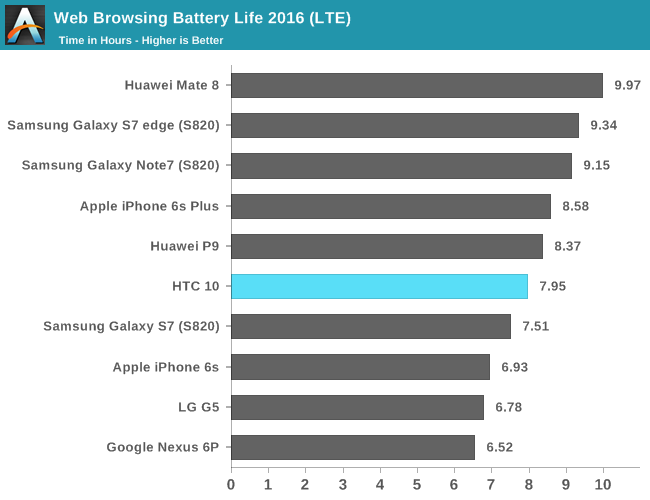
Moving on to the LTE version of this test we can see that HTC has really done an amazing job of implementing their cellular solution as battery life is basically identical to what it is on WiFi. It’s likely that poor reception conditions will tilt the scales back towards WiFi but in areas of good reception the HTC 10 has relatively good battery life on LTE. This is probably compounded by the fact that the HTC 10’s LTE reception is actually significantly above anything else I’ve used in recent memory including the LG G5 and Galaxy S7.
In the interest of trying to see whether this sort of pattern holds across the board, PCMark is another test that emphasizes power consumption but rather than just web browsing it attempts to have a mix of CPU and GPU usage in general purpose tasks as well as some general purpose IP blocks like video decode. While a relatively small part of overall power consumption, storage power consumption is also a part of the test as things like the photo editing subtest will involve reading and writing to non-volatile storage.
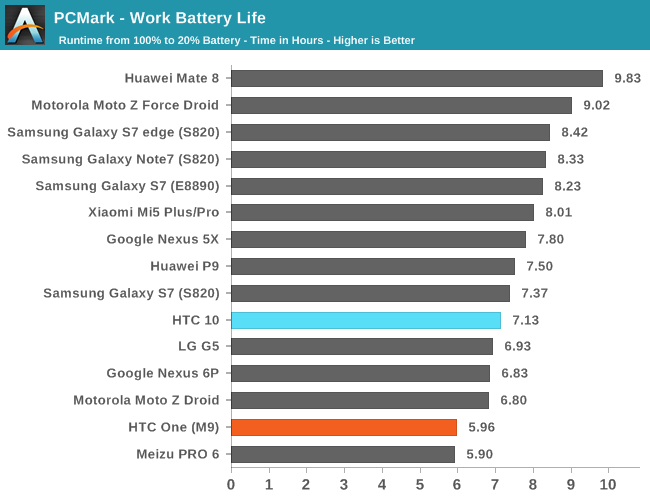
Interestingly enough, the HTC 10 ends up being slightly behind the Galaxy S7 here. Again, it’s likely that we’re looking at the difference in display power here as the Galaxy S7’s 1440p AMOLED display has a lower subpixel density and in a few tests the average picture level is relatively low. HTC is also using an ever so slightly larger display which would tilt the scales as well. Of course, none of this really changes the fact that display-bound workloads are going to see the HTC 10 performing worse than the Galaxy S7, but from an academic perspective it’s interesting to keep tabs on how AMOLED and LCD compare in terms of efficiency. It goes without saying that the Galaxy S7 edge with its huge battery easily pulls away from the HTC 10 and pretty much anything on the market but if you want a phone usable with one hand I would argue that the Galaxy S7 edge isn’t really a one-handed phone.
Moving on to the sustained rundown tests we can take a look at how an OEM has chosen to optimize their thermal management strategies, which often vary from device to device despite similar SoC and design. While we used to run Basemark OS II and GFXBench for this part of the test due to the arguably misleading results that Basemark OS II provides we’ve dropped it entirely to improve the signal to noise ratio of our reviews.
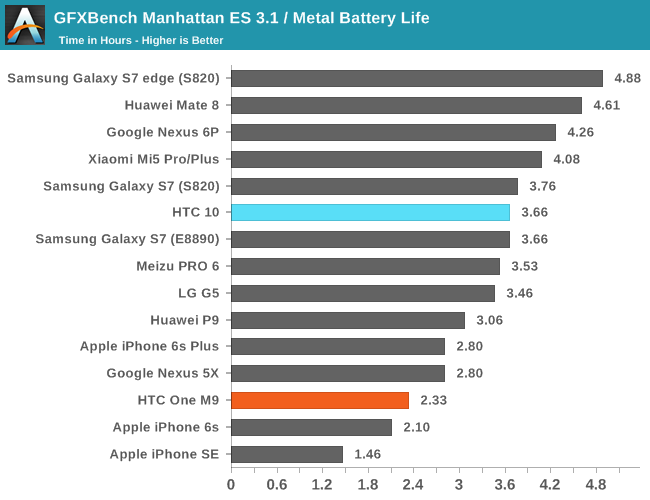
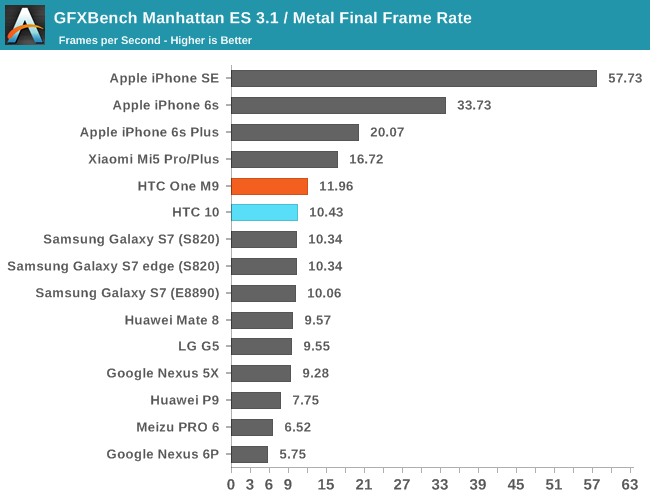
In GFXBench’s Manhattan ES 3.1 infinite rundown again we’re seeing the differences that come from display efficiency deltas but the difference is so small because SoC is pretty much the dominating factor when a display of this size will consume about a watt and the TDP-limited power consumption of the SoC is about two watts. What is noteworthy here is that HTC tends to do a better job of throttling the SoC such that the degradation is graceful. Samsung and LG both seem to favor maximizing short term performance which results in underdamped behavior which actually has a pretty appreciable impact on things like VR performance although given that no OEM is shipping Daydream-ready devices yet it isn’t necessarily critical for an OEM to be getting throttling right.
Overall, HTC does manages to pull in fairly respectable battery life despite being down on display efficiency. Our new tests manage to highlight the surprising level of optimization that HTC has put into the 10, but in use cases where you can’t really optimize things like cellular connectivity or governor behavior the HTC 10 slightly trails the Galaxy S7. When compared against something like the Galaxy S7 Exynos 8890 variants the HTC 10 is going to trail in anything CPU-bound as Kryo is just not as efficient as Exynos M1 for whatever reason. I don’t really think it’s a fair comparison but the Galaxy S7 edge is undoubtedly a big step up in battery life relative to the HTC 10, but this comparison only makes sense if you are willing to deal with the larger 5.5 inch display.
While I hate using screen-on time as a metric for battery life, generally speaking where the One M7 got about 3-4 hours of constant use when new the HTC 10 seems to achieve about 6 hours of use or so which is much more than what the 30% bump in battery capacity would suggest, especially once you factor in the half inch difference in display size, so the efficiency benefits of newer SoCs like the Snapdragon 820 are absolutely noticeable.
Charge Time
While battery life is probably the single most important metric of a mobile device, it’s important to not forget that these devices still need to spend at least some time wired up, whether directly in the form of an AC adapter or indirectly by swapping batteries. As a result it’s important to see how quickly the device’s battery will charge as generally speaking end users don’t hotswap batteries and charging the phone’s battery with an AC adapter is the dominant use case where charge time matters. To test this we use a number of methods, but for this review we will rely on measurements from the wall and using the time it takes for the device to drop to a certain level of power draw from the wall to indicate a full charge state, which is generally quite close to the time it takes for the device itself to indicate 100% but may take longer depending upon how an OEM adjusts battery state of charge determination and presentation.

It turns out that the HTC 10 charges fairly quickly, but it’s not necessarily as fast as what something with QC 2.0. This might seem counter-intuitive but realistically it’s not supposed to be faster than QC 2.0, but to reduce battery and device heating to better preserve the battery over time. Regardless, pretty much anything that charges in under 2 hours is going to be fairly comparable here. The Galaxy S7 does charge faster, but at the cost of overall battery lifetime. The LG G5 is actually slightly slower to charge here, so all things considered the HTC 10 is doing pretty well here. The one notable winner here is the OnePlus 3, which seems to charge quickly with relatively low battery heat due to its proprietary Dash Charge system.


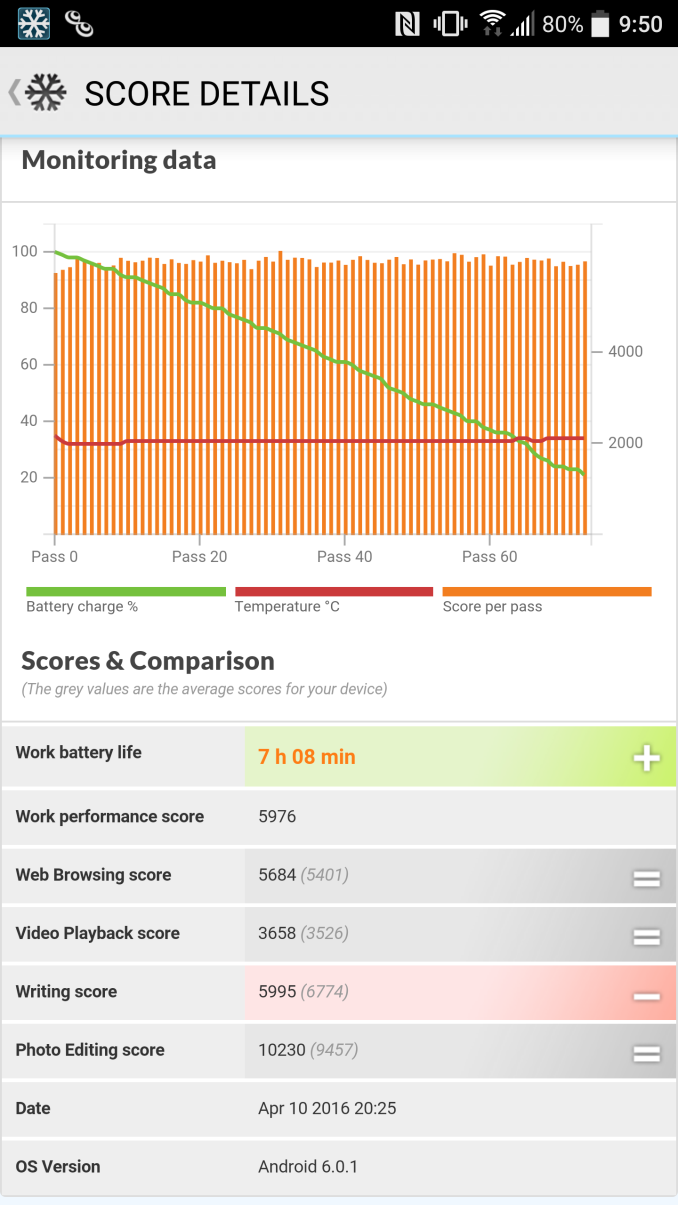
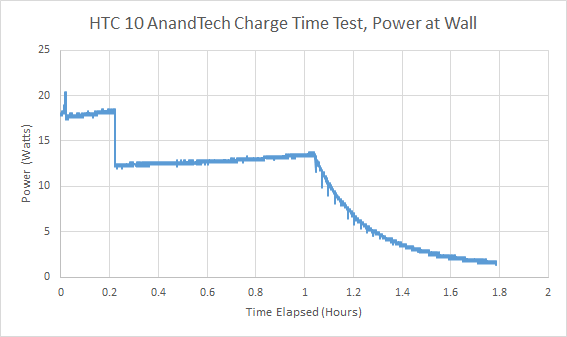








183 Comments
View All Comments
Badelhas - Tuesday, September 20, 2016 - link
Very well putJKJK - Tuesday, September 20, 2016 - link
Anand actually started to measure sound quality of phones before he left, but it ended up dead in the water after 2-3 models.I think GSM Arena has audio measurements. This is important for me, and the reason for buying M7, M8 and M9. Not sure about the pre/dac in HTC10 thought. But I just ordered the HTC10, so I'll find out soon!
Zoomer - Thursday, September 22, 2016 - link
Tested with my AKG K550. Drives it pretty easily. Quite transparent, and the boomsound profile can act as a EQ to cure deficiencies.Haldi - Monday, September 19, 2016 - link
There is definitely a separate DAC in the HTC10, it's called Aqstic.From the official Qualcomm website.... https://www.qualcomm.com/news/snapdragon/2016/06/0...
If you take a look at some tests HTC10 vs G5 or S7 you can see a huge difference.
Oh yeah, and Talking about PowerBiotics.... HTC's TaskScheduler which reduces the Load on Big cores when the phone gets too hot sucks. Really. 4th core is going almost offline if the phone gets too hot. Welcome to Triplecore world!
And charging from 1% to 100% Takes roughly 90 Minutes. Charging from 1% untill it stops/constant current is 150 Minutes. Anandtech's "using the time it takes for the device to drop to a certain level of power draw from the wall" is somewhat inbetween this.
P.S if you think the EIS in video recording works fine, go into a pineforest and take a video of the Peaks. Slowly paning from left to right. 1080p only.
ACM.1899 - Monday, September 19, 2016 - link
if it's integrated within SD820 why don't other smartphone such as mi5 sound as good.unless it's another chip...
ACM.1899 - Monday, September 19, 2016 - link
and i think Mi5 SD820 chip is not the same as in other flagship.philehidiot - Monday, September 19, 2016 - link
Just a thought but as you quite rightly said the OEMs don't pay attention to anything you don't test.... My HTC M9 seems to be very dodgy when placed in an area known for consistent 4G signal and will sometimes take ages to switch from "G" or "E" to "4G" - sometimes it will do it briskly and sometimes it will take an age and some prodding. Is there anyway you can test how the modems cope and adapt to various data signals being available?Unhappyhtc10 - Monday, September 19, 2016 - link
Bought it 2/3 weeks ago!At first it looked good with the quality of pictures, great sound, organiser (pictures, music etc...) and of course on paper make you want to give a try!!
After taking some time to get my hand around it (i had an iphone) i noticed that a lot of the functionnalities are not even close or inexistant than on a samsung. For ei you can have skype BUT can't even use the video! Can only take the voice. Then i am told to have another app that no one who use skype will have... I mean really?? And their is other stuff suche as the keyboard sensitivity, battery life which advertise lasting 27 hours on phone call supposedly but after about 45mins on the gps google map it drained it from 100% to circa 55% (you better not be traveling far...)
Conclusion: i have past the 14 days exchange at the store so if i can't exchange it i will be stuck with this crap!! (have it for 20days)
fanofanand - Monday, September 19, 2016 - link
Considering you created a profile just to make that comment, I'd say you seem like the typical Apple customer, and that's where you would likely be happiest. Everything you wrote screams of "user error". Go back to your shiny gadget and be happy.Zoomer - Tuesday, September 20, 2016 - link
I have the ten and can say that I've not noticed the battery issues with navigation. Besides, what does talk time claims have to do with gps?Sounds like a troll since the organizer is play music and Google photos. A stated in the article.